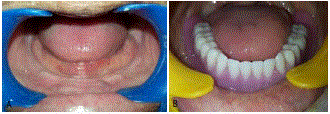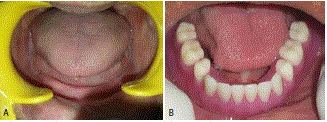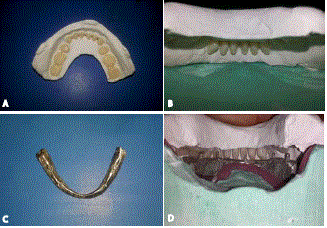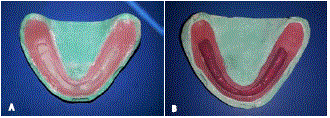Case Report
Improving Success Rate with Increased Weight of Denture for Poorly Resorbed Mandibular Ridge Patients: A Case Report Series
Parikshit Gupt*, Vishal Katna, Archana Nagpal, Kamal Kishore Kashyap and Surbhi Abrol
Department of Prosthodontics, Himachal Dental College, India
*Corresponding author: Parikshit Gupt, Department of Prosthodontics, Himachal Dental College, Sunder Nagar, Sundernagar Mandi, Himachal Pradesh 175019, India
Published: 18 Jul, 2017
Cite this article as: Gupt P, Katna V, Nagpal A, Kashyap
KK, Abrol S. Improving Success Rate
with Increased Weight of Denture for
Poorly Resorbed Mandibular Ridge
Patients: A Case Report Series. Ann
Clin Case Rep. 2017; 2: 1405.
Abstract
Added weight to mandibular denture is an easy and effective way in enhancing the retention and stability of the mandibular denture for efficient functioning. A case series of such resorbed ridge cases treated by adding weight using cast metal with its precise placement without altering the esthetics is described in this article.
Introduction
Resorbed mandibular ridge cases always present a clinical problem for their stability and
retention due to lack of bone height needed for stabilization from horizontal forces. With the
continued resorption of bone, the ridge is under the influence of functional musculature movements
which can easily dislodge the denture [1].
Instability and discomfort in conventional denture is attributed to the degree of resorption of
mandibular alveolar ridge. This condition can be managed by various surgical treatment options
like implantation, augmentation or vestibuloplasty. Certain situations may not allow the clinician
for surgical interventions, because of either patient’s medical conditions, affordability or patient’s
personal preference. To deal with such scenario with patient’s constrains and deficient foundation
area, a stable, strong and functional mandibular denture can be fabricated by alterations in its
fabrication, that may include modification in either impression making, jaw relation, teeth selection
and setting or alteration in designing of the denture.
One alteration in designing of the denture is to increase its weight to aid in its stabilization and
retention, by the effect of gravity. The idea of increased weight of mandibular denture to provide
stability is not new. It was introduced by Grunewald [2], where he used gold as a metal denture base
to increase the weight and suggested that mandibular denture base weighing 32 gms is effective for
achieving satisfactory retention.
Belfiglio et al. [3] and Wormley et al. [4], have described various techniques to increase weight
of the denture by fabricating a metal base dentures. But metal based dentures have problems of
adjustment, relining and irritation to the tissues. Massad et al. [5] described a technique to fabricate a metal base denture for highly resorbed mandibular ridge with a resilient liner. Hurtado et al. [6] also mentioned a technique to fabricate internally weighted denture.
Kim et al. [7] have described a method for fabricating a mandibular denture with increased
weight by precisely locating the position of the cast metal in the denture by making a permanent
heat cure denture base and securing the teeth arrangement in a plaster index. This design didn’t
affect the esthetics of the denture and also provided an acrylic base which could be relined in future
if required.
This article here presents the case report of three cases by use of internally weighted mandibular
denture as described by Kim et al. [7], to achieve successful results.
Case Presentation
Case 1
A completely edentulous, 55 year old male reported to the Department of Prosthodontics of
Himachal Dental College Sunder Nagar, Himachal Pradesh, India, presented with mandibular
edentulism and asked for a new set of artificial teeth. A thorough medical and dental examination was done. Mandibular ridge was found to be of order 6 classified
according to Atwood and maxillary anterior ridge was found to
be flabby. Mandibular ridge was so severely resorbed that buccal
and lingual vestibule and crest of the ridge, all were found a same
level. Patient was also diabetic. Treatment planned was fabrication
maxillary denture with relief for flabby ridge and internally weighted
mandibular denture with closed mouth impression technique (Figure
1A and 1B).
Case 2
A 65-year-old completely edentulous female reported to the
Department of Prosthodontics of Himachal Dental College, Sunder
Nagar, Himachal Pradesh, India who was using her 10 year old
dentures but was not able to chew food efficiently and wanted to get
a new set of denture. Mandibular ridge was found to be of order 6
classified according to Atwood classification. Mandibular denture
was planned to be designed with increase weight using cast metal with
conventional maxillary denture (Figure 2A and 2B).
Case 3
A 70-year-old completely edentulous female reported to the
Department of Prosthodontics of Himachal Dental College, Sunder
Nagar, Himachal Pradesh, India with her old dentures to be repaired.
However, the condition of the denture base was poor with attrited
teeth. So a new denture was advised. Intro oral examination revealed
severely resorbed mandibular ridge of order 6. Mandibular impression
was made by closed mouth technique and an internally weighted cast
metal denture was fabricated with conventional maxillary denture
(Figure 3A and 3B).
Figure 1
Figure 2
Figure 3
Figure 4
Figure 4
A) Plaster index with secured teeth setting. B) Checking clearance
with plaster index on master cast. C) Cast metal. D) Checking clearance
for acrylic resin with processed denture base, cast metal and plaster index.
Figure 5
Discussion
An internally weighted mandibular denture in one of the noninvasive
treatment option indicated for severely resorbed mandibular
ridge cases, which provide stability retention and function to the
mandibular denture without altering the esthetics of the dentures. It
is possible only by the accurate and precise placement of the internal
cast metal structure with a calculated weight. Various methods
described in literature by authors gave an idea about the amount
weight to be added to the denture for gravity to be effective and the
techniques for inclusion of metal into the denture. But the technique
of incorporating the cast metal is the most effective and accurate among all, and it also gives an option to for relining or rebasing if needed in future.
Checking for the sufficient clearance for cast metal is easy in
this design by preparation of a plaster index that secures the teeth
arrangement (Figure 4A,B,C and D). This design allows visualizing
the placement of cast metal accurately in the denture by fabrication of
permanent heat cure denture base with slot for its placement, which
will prevent the dislodgment of or exposure of cast metal which is
always a problem when using amalgam pellets for increased weight
(Figure 5A and B).
The only disadvantage is the increase in laboratory steps and the
cost, but this is negligible compared to its advantages and worth.
However, such increased weight dentures are not indicated for
the patients with weak labial musculature or those who stoop. In bent
position, the weight of denture will make it to fall out of the mouth.
Conclusion
Increased weight of mandibular denture is an easy and convenient method of dealing with highly resorbed ridge case and should be considered before taking up the invasive surgical procedures that have unpredictable results.
References
- Brill N, Tryde G, Cantor R. The dynamic nature of the mandibular denture space. J Prosthet Dent. 1965; 15: 401-418.
- Grunewald AH. Gold base mandibular dentures. J Prosthet Dent. 1964; 14: 432-41.
- Belfiglio EJ. Using metal bases in making complete dentures. J Prosthet Dent. 1987; 58: 314-317.
- Wormley JH, Brunton DA. Weighted mandibular dentures. J Prosthet Dent. 1974; 32: 101-102.
- Massad JJ. A metal-based denture with soft liner to accommodate the severely resorbed mandibular alveolar ridge. J Prosthet Dent. 1987; 57: 707-711.
- Hurtado AJ. Internally weighted mandibular dentures. J Prosthet Dent. 1988; 60: 122-123.
- Kim H, Brewer JD, Monaco E. Internally weighted mandibular denture fabrication using a processed denture base, J Prosthet Dent. 2009; 102: 123-125.





